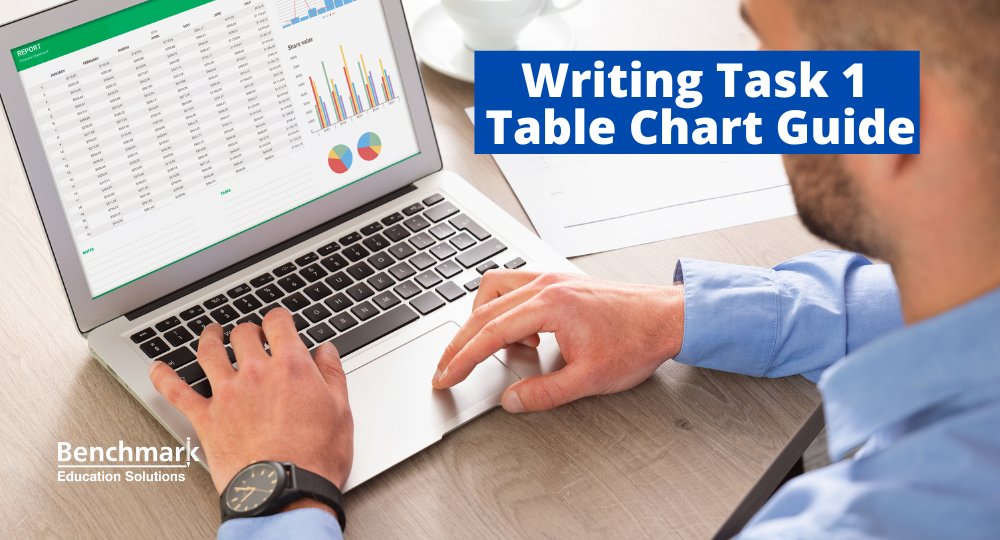

This guide will help you to prepare to answer table questions in the IELTS Academic Writing Task 1 part of the exam. Read on for example questions, tips, sample answers and much more!
Table of Contents
- IELTS Table Writing Overview
- IELTS Task 1 Table Questions
- Structure for IELTS Table Questions
- IELTS Writing Task 1 Band Descriptors Explained
- Vocabulary for IELTS Table
- Grammar for IELTS Writing Task 1 Table
- IELTS Writing Task 1 Table Sample Answer
- Common Mistakes and How to Avoid Them
- Quiz- Check Your Understanding
1. IELTS Table Overview
One type of IELTS writing task 1 is a table that presents information in columns and rows.
You may be given one table, two tables, or a combination question (see our guides on combination questions with tables and pie and bar charts).
1.1 Objective
You need to produce a formal report that summarises the key information given in the table(s). Your IELTS report should be factual (do not include your opinion) and you must write at least 150 words. You may need to compare data from different periods of time, only one given year, or there may be no date provided.
1.2 Skills Used
This IELTS writing task is testing your ability to select and summarise key information from a table and make comparisons between categories. You must also show that you understand the difference between a formal report (IELTS writing task 1) and an essay (writing task 2). To do this, your report should:
- Not include the first person ‘I’ at any point (e.g. write ‘The graph shows…’ not ‘I think the graph shows’)
- Not use contractions (e.g. use ‘It is…’ not ‘it’s)
2. IELTS Task 1 Table Questions
2.1 Tables with One Year
Here is an example of what a typical table might look like:
| International Price Comparison Index in £ sterling (2010) | |||||
|---|---|---|---|---|---|
| Cheese (100g) | Bread (1 loaf) | Milk (1 pint) | Burger (from restaurant) | Americano (from coffee shop) | |
| England | £2.50 | £1.50 | £1.50 | £4.00 | £2.50 |
| Wales | £2.40 | £1.10 | £1.00 | £3.00 | £2.00 |
| Northern Ireland | £2.30 | £1.30 | £1.40 | £3.50 | £2.20 |
| Scotland | £2.30 | £1.20 | £1.40 | £3.00 | £2.30 |
2.2 Tables With Multiple Years
Here is a table where you are given data to compare from the past and present:
Reasons for adults attending the theatre (in %) in London
| 20 years ago | 10 years ago | Today | |
|---|---|---|---|
| For a special occasion (e.g. a birthday | 9 | 24 | 55 |
| For a business event | 58 | 56 | 20 |
| For a family trip | 27 | 9 | 15 |
| Bought a voucher by a friend/relative | 6 | 11 | 10 |
3. Structure for IELTS Table Questions
3.1 Introduction
The first paragraph of your report for an IELTS writing task 1 table should paraphrase (rewrite in your own words) the given statement. The IELTS statement is usually given above the table and will give you a brief description of the data shown.
Here are some ways you could start your report:
- The table shows…
- The table gives details about…
- The table provides information about…
- The table summarises information about…
- The table compares…
Paraphrasing means writing something into your own words and maintaining the same meaning. You can do this by using synonyms, similar phrases, changing the word order of the sentence in some way (such as changing the active to the passive voice) or changing the word class of words (e.g. changing a noun to a verb form).
See this example of a paraphrased statement:
Original statement:
The table below shows the figures for genres of TV programmes watched on a streaming service by country in millions.
Paraphrased statement:
The table compares four countries in terms of the number of people, in millions, who watched four different genres of television programmes (comedy, horror, documentary, and true crime) on a streaming service.
Main changes:
- ‘The table below…’ becomes the table ‘The table compares…’
- ‘…the figures for genres of TV programmes’ becomes ‘four different genres of television programmes’
- Brackets are used to give the specific television genres. Note- do not put a very long list within brackets, and do not over use brackets in your report.
- …in millions…’ becomes ‘…people, in millions,…’
3.2 Overview
With all IELTS writing task 1 reports, you must always include an overview paragraph after your introduction. Your overview should provide the general trends shown in the table without going into detail.
Here are some things to consider when writing an overview for tables:
- Start your overview with ‘Overall…’ to make it easy for the examiner to locate your overview paragraph. Other possible words / phrases are:
- In summary,…
- Broadly, it can be seen that..
- To summarise,…
- Mention each category in the table but do not describe all the data for each category (e.g. if four countries are mentioned you should write something about all four countries, but not all the figures related to each one)
- Try to group the data in some way using your general knowledge e.g. group sweet and savoury food
- Look for the key features of the table (the highest/lowest/ most significant figures)
3.3 Main Body Paragraphs
Your main body paragraphs are where you go into detail about the features mentioned in your overview.
You should consider the following points:
- Decide if you need to use language to compare and contrast, or language to describe changes over time
- You can describe the average of a range of data
- Do not try and describe all the data given in the table(s)
- Vary your sentence structures (use a range of simple and complex sentences)
- If you are given dates, make sure to use a range of correct tense
- Use linking phrases
- Use a range of comparative language to compare date on the table (see Vocabulary for IELTS Tables)
- Organise your body paragraphs according to the categories you used in your overview
- Leave a line between each paragraph to make your report structure clear for the examiner
4. IELTS Writing Task 1 Band Descriptors Explained
Our section on IELTS Writing Band descriptors for IELTS writing Task 1 explains how to succeed in: Task achievement, Coherence and Cohesion, Lexical Range and Accuracy, and Grammatical Range and Accuracy.
5. Vocabulary for IELTS Tables
5.1 Comparative Language
Here are some useful phrases to use when comparing data from a table:
Examples:
Spanish was far more popular for men than women.
Twice as many women as men chose to study Welsh.
A considerably higher number of men than women chose to study Arabic.
The number of women who studied French was slightly higher than that of men.
Far more men than women studied French.
Japanese was equally popular for women and men.
6. Grammar for IELTS Writing Task 1 Table
6.1 Comparative Structures
Form
X is as _____ as Y
X is not as _____ as Y
Examples:
A one-bedroom flat is as expensive in the UK as in the USA, at £700 and £720 per month.
A woman’s haircut in the USA is not as expensive as in the UK, at £35 and £45.
A burger from a UK restaurant is not as expensive as a burger in the USA, at £1.20 and £2.00.
Other useful structures
- X is 50% the price of Y
- X is double the price of Y
- X is the same price as Y
- X is much less expensive than…
- X is slightly less expensive than…
- X is not quite as expensive as…
- X is twice/ three times cheaper than Y
7. IELTS Writing Task 1 Table Sample Answer
The table shows a breakdown of the most popular languages taken by native English speakers studying at the UK Centre for Foreign Language Learning in 2020.
Summarise the charts by selecting and reporting the main features and make comparisons where relevant.
| Language | Women | Men |
|---|---|---|
| Mandarin | 27% | 14% |
| Spanish | 19% | 19% |
| Arabic | 10% | 22% |
| French | 10% | 5% |
| Italian | 3% | 5% |
| German | 7% | 14% |
| Polish | 11% | 3% |
| Japanese | 9% | 10% |
| Welsh | 4% | 8% |
The table highlights information about the percentage of English native speaking women and men that studied one of nine foreign languages at a foreign language school in the UK in 2020.
Overall, what stands out from the table is that Arabic was the most popular language for men, while Mandarin was more popular than other languages for women. Another interesting point is that the biggest difference in percentage between genders related to Mandarin.
In detail, if we look at Welsh, it was twice as popular with men than with women, at 8% and 4% respectively. Similarly, German was two times as popular for men with 14% as opposed to women at 7%. The largest difference in language studies for men and women was Mandarin, at 14% and 27%.
Conversely, Spanish was as popular with women as with men at 19% for both genres. Likewise, there was a slight difference in the number of men (9%) and women (10%) studying Japanese. Finally, Italian, this was the least popular language for women coming in at only 3% followed closely by men at 5%.
7.1 Sample Answer Commentary
The report above would receive an estimated 9.0 overall in the IELTS writing task 1 Academic paper.
It has been organised into four logical paragraphs that are clearly divided into an introduction, overview, and two separate body paragraphs.
The overview paragraph has been clearly signposted using ‘overall’ and the key features introduced with the phrase ‘what stands out from the table’. Only the key features have been stated and the writer has not gone into detail. The superlative ‘the most popular language’ has been used to rank the information. A range of other comparative language has been used successfully, such as ‘the most popular’, ‘more popular than’, ‘the biggest difference’, ‘two times as popular’ and ‘twice as popular’.
A range of linking devices have been used successfully such as ‘conversely’, ‘similarly’, and ‘finally’.
Further details have been given in the main body paragraphs using comparative structures ’ e.g. ‘Spanish was as popular with women as with men’.
8. Common Errors and How to Avoid Them
8.1 Problem 1
Problem 1
Difficulty locating the key features of the table.
Solution 1
IELTS Candidates often struggle with identifying the key features of a table as it might not be as clear as a graph or chart. One solution is to look for the highest and lowest numbers on your table and ask yourself:
- What are the largest numbers?
- What are the smallest numbers?
- Which numbers show the biggest difference?
- Which numbers are similar?
The answers to these questions will help you to identify the key features of the table.
8.2 Problem 2
Problem 2
Only writing about one table when more than one are given
Solution 2
If you are given more than one table, then you need to summarise data from each table to do well in the task achievement’ marking component. Remember, you do not need to write about every single detail, only the main trends.
9. Quiz- Check Your Understanding
Take this short quiz to test your understanding of writing task 1 and tables:










There is an error in answers of 9th and 10th question. It is being impossible to select the answer for 10th question, if you already choose the answer for 9th one. It will be great, if the problem is fixed.
fixed, thanks.
Hello,
Thank you for the great article.
I just want to point out that the following sentence in TASK 1 sample answer seems incomplete; fragment.
“Another interesting point is that the biggest difference in percentage between genders related to Mandarin.”
Can you account for it please as I am not sure how to fix it?
Thanks